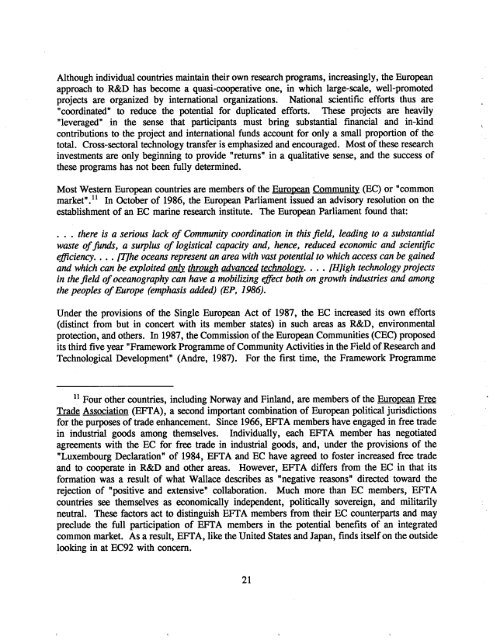WHOI-90-52
WHOI-90-52
WHOI-90-52
Create successful ePaper yourself
Turn your PDF publications into a flip-book with our unique Google optimized e-Paper software.
Although individual countries maintan their own resech programs, increasingly, the Europe<br />
approach to R&D has becme a quasi-cooperative one, in which large-sce, well-promote<br />
projects are organized by international organizations. National scientific efforts thus are<br />
"coordinated" to reduce the potential for duplicated efforts. These projects are heavily<br />
"leveraged" in the sense that parcipants must bring substatial financial and in-kind<br />
contrbutions to the project and international funds account for only a small proporton of the<br />
tota. Cross-setoral technology transfer is emphasize and encouraged. Most of these resech<br />
investments are only beginning to provide "returns" in a qualitative sense, and the success of<br />
these programs has not been fully determined.<br />
Most Western Europe countres are members of the Europe Community (EC) or "common<br />
market" . 11 In October of 1986, the Europe Parliament issued an advisory resolution on the<br />
establishment of an EC marne resech institute. The Europe Parliament found that:<br />
. . . there is a serious lack of Community coordination in this field, leading to a substantial<br />
waste of fund, a surplus of logistical capacity and, hence, reduced economic and scientifc<br />
effcienc. . . . /Tlhe oceans represent an area with vast potential to which access can be gained<br />
and which can be exploited only through advanced technology. . . . fHligh technology projects<br />
in the field of oceanography can have a mobilzing effect both on growth industries and among<br />
the peoples of Europe (emphais add) (BP, 1986).<br />
Under the provisions of the Single Europe Act of 1987, the EC increase its own efforts<br />
(distinct from but in concert with its member states) in such areas as R&D, environmenta<br />
protection, and others. In 1987, the Commission of the Europe Communities (CEC) propose<br />
its third five yea "Framework Programme of Community Activities in the Field of Resech and<br />
Technological Development" (Andre, 1987). For the first time, the Framework Programme<br />
11 Four other countries, including Norway and Finland, are members of the Europe Free<br />
Trade Association (EFTA), a seond importt combination of Europe politica jurisdictions<br />
for the purpses of trde enhancement. Since 1966, EFTA members have engaged in free trde<br />
in industral goos among themselves. Individually, each EFT A member has negotiate<br />
agreements with the EC for free trade in industral goos, and, under the provisions of the<br />
"Luxembourg Declaration" of 1984, EFTA and EC have agree to foster increase free trade<br />
and to cooperate in R&D and other areas. However, EFT A differs from the EC in that its<br />
formation was a result of what Wallace describes as "negative reasons" directed toward the<br />
rejection of "positive and extensive" collaboration. Much more than EC members, EFT A<br />
countres se themselves as economicaly independent, politicaly sovereign, and miltaly<br />
neutral. These factors act to distinguish EFT A members from their EC counterpars and may<br />
preclude the full parcipation of EFT A members in the potential benefits of an integrated<br />
common market. As a result, EFT A, like the United States and Japan, finds itself on the outside<br />
lookig in at EC92 with concern.<br />
21
















